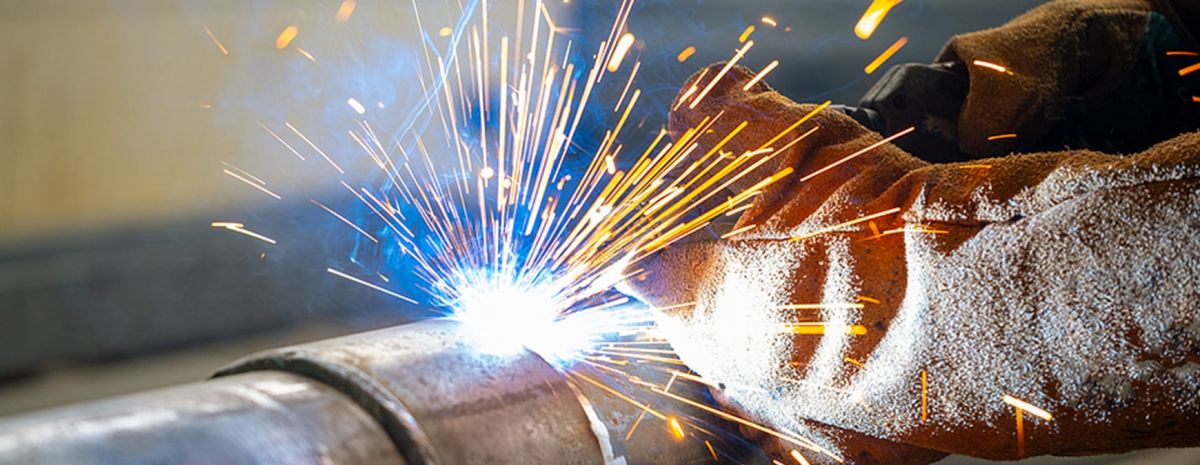TWS is a Great Training Option for Everyone
Learn more about how we can prepare you to advance your career.
Arc welding uses the power of an electric current to join two metals.1 The power supply for the electric current is transferred from a welding electrode (or a “metal stick”) to the base metal, creating an “arc” that melts the metals upon contact.1 This process requires intense heat, and after the metals have cooled, a metallurgical bond is created.2
There are many different types of arc welding, from manual to semi-automatic to fully automated, but all require an electrode and an electric current to bond two metals, which creates an arc upon contact.1
Types of Arc Welding
DC vs. AC Currents
The electric power supply for arc welding can come from either a direct (DC) or alternating (AC) current.1
Direct current (DC) arc welding is often used in stick welding and lower-voltage cases, and is generally preferred over AC. This is because the DC current uses electrons that flow steadily in one direction, creating a smoother and more stable arc.3
Have You Considered a Career in the Skilled Trades?
Fill out the form to recieve a no obligation info packet.
Alternating current (AC) arc welding has greater volatility in the electrons, as they change direction constantly. AC current is usually a secondary choice in welding, but can be helpful in some instances, like when a stronger current is needed to prevent the arc from blowing out or for transmitting electricity over large distances.3
Consumable vs. Non-Consumable Arc Welding
The electrodes (or “sticks” or “rods”) used in arc welding can be either consumable or non-consumable.1
A consumable electrode not only conducts the current but also supplies filler metal to the joint. This means the electrode is made of a type of metal that melts along with the metals being welded together. This type of welding is often used in the manufacture of steel products.2,4
A non-consumable electrode, on the other hand, is made of material that is not melted during the weld, such as tungsten, which has an extremely high melting point.4
Consumable Arc Welding Types
- MIG (Metal Inert Gas) welding, also known as GMAW (Gas Metal Arc Welding), uses an inert shielding gas to protect the work metals from contamination. When welding aluminum, these inert gases can be argon or helium, for example.5
- MAG (Metal Active Gas) welding uses active gases, rather than inert gases, primarily for the welding of steels.5
- SMAW (Shielded Metal Arc Welding) is also called “stick welding” or flux shielded arc welding. In this process, the electrode is flux coated, and a weld pool is formed when the high heat is applied. This is a versatile method of arc welding.6
- FCAW (Fluxed Core Arc Welding) is an alternative to SMAW. This method uses a constant voltage power supply along with a consumable flux cored electrode, which creates a constant arc length.6
Non-Consumable Arc Welding Types
- TIG (Tungsten Inert Gas) welding uses a non-consumable electrode made of tungsten. Tungsten’s melting point is around 6,000 degrees Fahrenheit, so it does not melt during the welding process.4
- PAW (Plasma Arc Welding) is similar to TIG welding, and also uses tungsten. A plasma welding torch is used, however, which is usually water-cooled.7
Each one of these different types of arc welding has specific considerations, such as which type of electrode and current to use for safe and optimal welding. Entry level welding training can teach many of these welding processes hands-on.
Welding Education
Arc welding is one type of welding that is generally taught in welding school.
At Tulsa Welding School, different welding programs offer different specialized training courses in welding. For example, the Professional Welder training program, which can be completed in seven months, features instruction in some of the arc welding types mentioned above, like SMAW, MIG, and TIG welding.
If you’d like to learn more about how to get started with welding training, call (855) 237-7711 to learn more about what a welding education could look like for you.
Applications of Arc Welding

Arc welding was first developed in the late 1800s and played an important role in shipbuilding during WWII.1 Arc welding is so important to shipbuilding because ensuring a water-tight surface is essential for creating a safe and seaworthy vessel.8
Today, arc welding is still a key part of shipbuilding, and has other important roles in the automotive, construction and mechanical industries.9 Arc welding is an essential process to many large-scale construction projects, creating strong, enduring connections in buildings, bridges and other structures.8
In the automotive industry, every car requires around 1,000 welds. MIG welding, for instance, is often employed to make bonds between the thinner metals used in vehicles, such as aluminum.10 Arc welding is used in too many mechanical applications to count, anything from HVAC units to computer machinery to furniture to agricultural tools.8, 10
The Wide World of Arc Welding
As you can see, the world of arc welding can be wide and varied. The process can play an important role in the construction of critical infrastructure and the manufacture of numerous goods.
1https://en.wikipedia.org/wiki/Arc_welding
2https://lincolnelectric.com/en-us/support/process-and-theory/Pages/arc-welding-detail.aspx
3https://welderportal.com/what-is-the-difference-between-ac-and-dc-welding/
4https://fastenerengineering.com/whats-the-difference-between-consumable-and-non-consumable-electrodes-in-welding/
5https://www.twi-global.com/technical-knowledge/faqs/faq-what-is-mig-mag-welding
6https://www.twi-global.com/technical-knowledge/faqs/what-is-arc-welding
7https://www.sciencedirect.com/topics/engineering/plasma-welding
8https://www.imageindustries.com/blog/2016/03/15/industrial-applications-for-arc-welding/
9https://interestingengineering.com/types-of-welding-their-applications-advantages-and-disadvantages
10https://weldinginsider.com/6-welding-industries/#automotive-industry
This blog has been labeled as archived as it may no longer contain the most up-to-date data. For a list of all current blog posts, please visit our blog homepage at https://www.tws.edu/blog/







